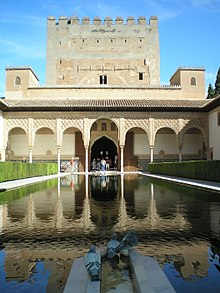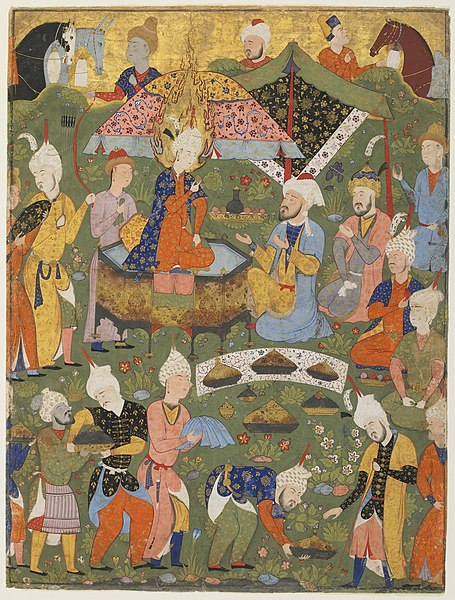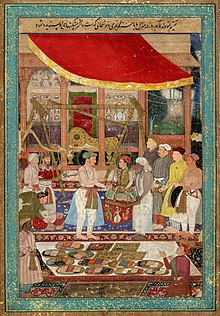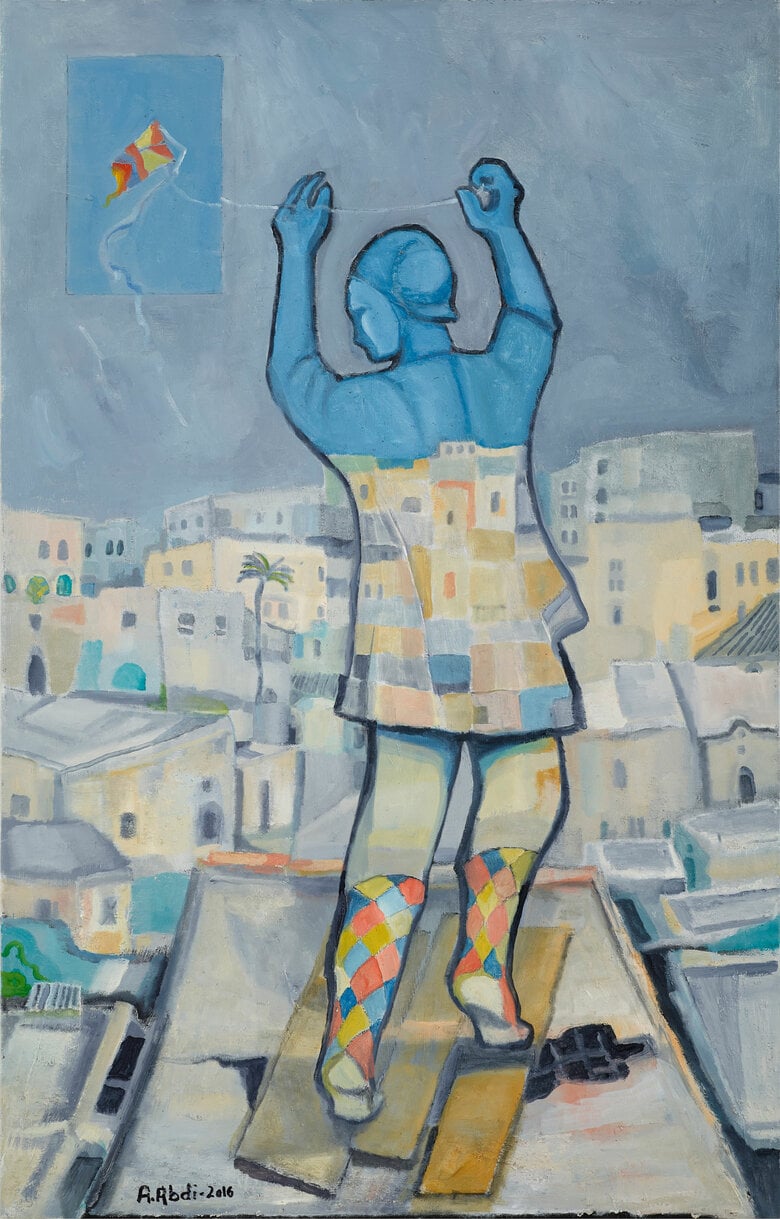Recently during my wandering on the Internet I found an article about the Islamic artist Mir Musavvir.
Musavvir (1510-1555) was Persian painter at the Safavid and Mughal courts who painted what Europeans might call illuminated manuscripts of scenes from the Islamic literature.
Musavvir's paintings remind me of European medieval art, which I love, and with his bright colours, more modern expressive art. I was reminded that there have been many Islamic Old Masters, whose skill often goes unacknowledged in many 'history of art' textbooks.
Contrary to what some people think painting is allowed in Islam. There are some restrictions - detailed pictures of animals are not allowed, nor anything which might offend Islam itself, nor caricatures or images of the prophet Mohammed nor anything which might encourage idolatry.
Islamic art seeks to explore and depict the nature of things as a way of understanding the nature of Allah, or God, the supreme being in Islam.
Islamic art generally has three guiding aspects: geometric patterns, floral patterns and calligraphy.
Geometry is important because the patterns can be endlessly repeated and thus remind the viewer that Allah is infinite, and that in the small the infinite can be found. Islamic art does not seek to represent what is material but rather its spiritual essence, since in Islam this is where its beauty lies.
I began to research Islamic art but found that there was less information available than for Western Art and its well-documented development. This is because Islam itself spread over such a wide area encompassing what is now India, Turkey, North Africa, the Middle East and for a while southern Spain. Between such disparate lands, art styles and techniques spread less quickly than in the relatively homogenous lands of Europe.
Nevertheless is is possible to write about the steady development of Islamic art.
Early Period
Mohammed died in 632. After this several caliphates ruled what was known as the Islamic Empire until 1258, when Mongol invaders destroyed Baghdad, its administrative heart.
Rashidun Caliphate (632-661)
During the era of this caliphate (632 - 661) the earliest Islamic art was made. Because the early Arab Muslims were mostly nomadic, making large works of art was impracticable. Art which was made was not directly derived from the Islamic holy books the Koran and the Hadith, unlike Christian art which was derived from Biblical stories.

The very first Islamic art was to decorate architecture in building the first mosques, early coins and finally calligraphy which was used to reproduce the prophet Mohammed's words. Calligraphy in the Arabic language became very important and still is, as this was the original language of Mohammed and the first language in which his revelations were written. Early Islamic art was also influenced by the established styles of the Byzantine and Iranian civilisations which ruled over the lands in which Islam began to spread.
Umayyad caliphate (661-750)
The Umayyad caliphate covered a wide area of the Middle East, North Africa and Spain and Arabic became its official language. Because many Christians and a few Jews lived in its territories it accommodated Christianity and Judaism, and high office could be held by non-Muslims. The art of Christendom and Byzantium influenced Umayyad art as can be seen in the example below, which depicts a figure from the folklore drawn from the interlinked Greek, Byzantine and Islamic culture of the time.

During this period Islamic art began to look distinctive and adapt the dominant styles of Eastern Mediterranean antiquity, especially in the decoration of mosques.
Golden Age
The Abbasid period (712-1258)
The Abbasid caliphate extended the range of the Islamic Empire's territories eastwards towards what is now India and northwards towards what is now Russia. Its capital was Baghdad.


Its art had grown in sophistication, but still showed some influences of Mediterranean art generally, which was hardly surprising as the Islamic ports and cities traded with European Christendom. Nevertheless it was during the Abbasid period that Islamic art became much more distinctive and branched away from Western and Classical art. It was here that the patterned style emerged which became known as 'arabesque'.
Arabesque patterns remind the viewer of nature's, and thus God's, patterns without directly reproducing nature itself.


Fatimid Art (909-1171)
The Fatimid dynasty claimed descent from Mohammed's daughter Fatima and expanded the Islamic Empire further to include more of Egypt, Tunisia, Sicily and Syria. They founded Cairo and made it their prosperous and powerful capital. Islamic art greatly grew and flowered, especially glassware, pottery and calligraphy. Arabesque patterns became more sophisticated, as did calligraphic art.


Attacks on the Fatimids' territories by European crusaders caused it to collapse into a number of dynasties in 1171. In 1258 the Mongols sacked Baghdad and brought the Islamic Golden Age to an end.
Almoravid Period (1056-1147)
The Almoravid dynasty conquered Morocco and made its capital in Marrakesh in 1062. In 1085 they captured Toledo in Spain and soon conquered further northwards. They disdained the opulent arts of Spain but eventually adopted the Spanish style.
Almohad Period (1130-1269)
In 1150 the Almohads conquered Morocco and many great Spanish cities such as Seville and Cordoba. They soon succumbed to counter-conquest by Christian armies from the north, and their territories were gradually eroded away. One Almohad principality - the Nasrid dynasty - survived long enough to create, over several generations, the great Alhambra Palace in Granada. In 1492 the last Muslim ruler was exiled from Spain which saw the end of Islamic political influence in Europe.


Middle Period
Il-Khanid Period (1256-1335)
In 1295 the Mongol ruler Ghazan converted to Islam and began a period of Mongol Islamic rule which lasted until 1335.
The art of this dynasty seems to mix Chinese and Islamic influences, which is hardly surprising given the Eastern edges of its territory were close to China.
Mamluk Period (1250-1517)
The Mamluk Sultanate emerged from the end of the previous Ayyubid dynasty which had branched off during the final years of the Islamic Empire. It was ruled by its military, who had defeated the Mongol invaders, until the Ottoman Empire conquered it in 1517. Its capital was Cairo which became the artistic and cultural capital of the Islamic world.
The Mamluks became prosperous due to trade in spices and silk. They became generous patrons of the arts. Mamluk decorative art - glassware, metalwork, wood carving and textiles - was the equal of anything made in Europe. It was popular throughout the Mediterranean and influenced the European arts in cities such as Venice with its famous glassware makers.


Iranian Safavid dynasty (1501-1736)
The Safavids united Iran into a powerful state and made Shia Islam its official religion, against its neighbours the Ottomans who were Sunni Muslims.
The Safavids patronised manuscript illustrators and this turned into a new and beautiful painting style which featured flattened colours similar is some ways to oriental painting.


Mir Musavvir (1510-1555)
A leading painter of the Safavid court was Mir Musavvir

Timurid Period (1370-1507)
This Mongol dynasty emerged from central Asia to rule Iran, Iraq, southern Russia and parts of Syria and Turkey. The leader Timur was a great patron of the arts and some great works were created in the fields of manuscript illustration, jade carving and and metalwork.
Timurid painting seems to be influenced by both Chinese and Islamic art traditions.
Ottoman and Late Period (1299-1922)
The Islamic world became a large mosaic of similar but differing cultures, as happened in European Christendom. In 1299 Turkish muslims founded the beginnings of the Ottoman Empire in what is now Turkey, and expanded it steadily over several generations. The conquest of Constantinople in 1453 ended the Byzantine Empire and the Ottomans became the dominant power of the eastern Mediterranean. By 1566 under Suleiman the Magnificent the Ottoman Empire was at the peak of its power, and controlled as much territory as the old Islamic Empire. It enjoyed a further almost two hundred years of stability until Europeans and Russians invaded many of its territories, which led to its dissolution after World War I.
Ottoman art was influenced by the territories and cultures it absorbed - Byzantine, Mamluk and Persian.

Ahmed Karahisari (1458-1566)
Karahisari is one of the most important Ottoman calligraphers, whose work is inspired by the calligraphy of the Abbasid dynasty.

Mughal Empire (1526-1857)
The Mughal Empire ruled over what is now India until its dissolution by the British Raj in 1857.
Babur School of Painting (1483 - 1530)
This Mughal school of painting was founded during Babur's rule and was characterised by books illustrated with complex paintings of various scenes drawn from Islamic history. The style was based on Chinese art.

Akbar School of Painting (1556 - 1605)
Under Akbar painting continued to flourish as he expanded the Mughal library. Akbar had apparently studied painting himself. The art of this era is confident and shows a flourishing and prosperous empire.

Jahangir School of Painting (1605 - 1625)
Jahangir was an admirer of European painting and under his rule the colours and brushwork of Mughal art became finer.

After Jahangir the Mughal Empire was steadily reduced in size and influence by the British colonialists, and later paintings were more formal.
Taj Mahal (1653)

This world famous building is one of the greatest achievements of Islamic art and architecture. Completed in 1653 for the Mughal emperor, Shah Jahan, this amazing building was a homage to his late wife Mumtaz Mahal.
Inside the building are many carvings and tiled images of natural features such as flowers and plants.

Modern Era
Islamic art flourishes to this day and still usually features its three guiding aspects: geometric patterns, floral patterns and calligraphy.
Modern Muslim artists often mix figurative elements alongside traditional patterns to make compelling work.
Abed Abdi
Abdi makes art which often reflects the turmoil and conflict which, alas, has featured in the modern Muslim world.


Asheer Akram
Akram uses modern techniques to create recognisably Islamic art.








